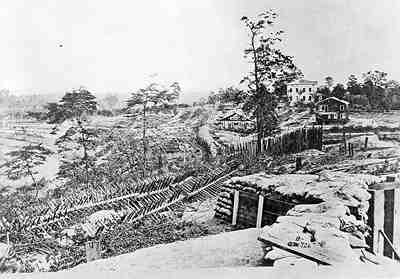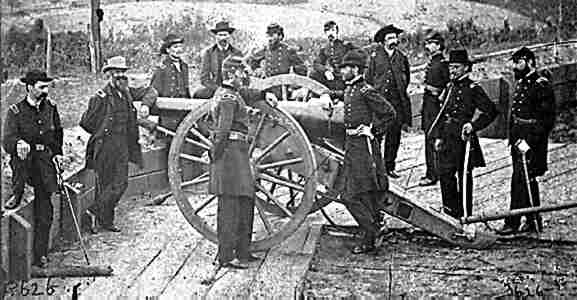
Atlanta Introduction
Touring Atlanta
The Atlanta Region Civil War sites, out of all the regions in the book, have
the greatest range of substance, style, and historic importance because of several
factors. First, Atlanta was burned by Federal troops in 1864, destroying most
historic structures. Second, Atlanta's civic leadership has generally been more
focused on constructing new buildings instead of saving older ones. Third, thanks
to this same leadership, the economic prosperity Atlanta has experienced —
like a phoenix rising from the ashes — has obliterated many battlefields,
as the railroad town of 10,000 has grown and developed to an urban area of more
than 2 million.
The good news for Civil War buffs is that some sites are in great condition
and available for touring. The Kennesaw Mountain National
Battlefield Park, opened in 1935 and covering 2,884 acres, is a gem, and
much can be experienced and learned by touring these historic grounds, where
you can actually see trenches from the battle and learn the life-and-death importance
of high ground. This park is in marked contrast to many of the battlefields
near Atlanta, which consist mainly of state historical
markers next to busy highways. Here, your imagination is needed. Although
most of the historic homes of Atlanta were razed or destroyed in battle by Sherman,
towns surrounding Atlanta — Marietta, Roswell,
Jonesboro, and Decatur —
have historic homes open to tours. There are excellent Cemeteries
to tour in the Atlanta area, including Oakland Cemetery,
the Confederate Cemetery in Marietta, Marietta
National Cemetery, the Patrick R. Cleburne
Memorial Cemetery in Jonesboro, and Westview Cemetery.
Good museums include the Atlanta History Center,
the Cyclorama, Kennesaw Civil
War Museum, and the DeKalb Historical Society
Museum. And don't forget Stone Mountain Park.
The North has the impressive Mount Rushmore, but the South has Stone Mountain,
a carving of Confederate heroes Robert E. Lee, Thomas J. "Stonewall"
Jackson, and Jefferson Davis. The South's is larger. If you can make it to one
of the summer's nightly laser shows to hear Elvis sing Dixie, then you've experienced
something uniquely southern.
Atlanta's History
Atlanta was the prize sought by the Union and for good reason. Atlanta was
second only to the Confederate capital of Richmond in importance to sustaining
the Confederate government. Atlanta, the "Gate City of the South,"
had become the transportation hub of the Confederate war machine, with four
railroads connecting here. Rail lines spoked out from Atlanta, going east to
the Atlantic seaboard states and the Eastern Theater and Richmond. West, it
was the backdoor to the blockaded Confederate seacoast states; north to Chattanooga
and the mid-south states and Western Theater; and south to the Atlantic seaboard
and port of Savannah. Atlanta served  as
a vital arsenal, and was a productive factory town manufacturing war materiel
of all kinds, from cannon and rifles to rails and armor plate, to uniforms and
even wooden coffins. Atlanta also was vital in supplying the Confederacy with
food supplies, connecting the rich farmlands and breadbasket of the south —
Georgia, Alabama, and Mississippi — with all other points of the Confederacy.
Early in the war, Georgia and Atlanta's geographic position in the heart of
the Confederacy insulated it from the more destructive ravages of war, except
for the coast. Georgians had answered the call of their new government, and
supplied approximately 112,000 men (some were among the best troops, generals,
and officers in government), who fought in almost every battle of the Civil
War. When Grant was commissioned General-in-Chief of the entire U.S. Army on
March 10, 1864, he appointed his friend W.T. Sherman as commander of the Western
Theater. At a meeting in Cincinnati, they agreed on a simple plan to end the
war: The two main armies would move simultaneously against the two great armies
of the Confederacy, with Grant pounding his way to Richmond and Sherman fighting
his way 100 miles from his base in Chattanooga to strategically important Atlanta.
This strategy would prevent the south from reinforcing either front, and either
Grant would get to Richmond first, or Sherman would help split the Confederacy
and strangle the Eastern Theater by destroying Atlanta. Thus the Atlanta
Campaign was born, which led to the major Civil War
events in the Atlanta area (after Sherman had fought his way through northwest
Georgia) from June 15 to Sept. 2, 1864 when Atlanta surrendered, including battles
at Gilgal Church, Kolb's Farm,
Kennesaw Mountain, Peachtree Creek,
Atlanta or Bald Hill, Ezra Church,
Utoy Creek, and Jonesboro.
Also in the Atlanta area was the beginning of one of the more famous stories
of the Civil War, the "Great Locomotive Chase,"
on April 12, 1862, and the start of Sherman's infamous "March
to the Sea"
on November 15, as Atlanta was in flames.
as
a vital arsenal, and was a productive factory town manufacturing war materiel
of all kinds, from cannon and rifles to rails and armor plate, to uniforms and
even wooden coffins. Atlanta also was vital in supplying the Confederacy with
food supplies, connecting the rich farmlands and breadbasket of the south —
Georgia, Alabama, and Mississippi — with all other points of the Confederacy.
Early in the war, Georgia and Atlanta's geographic position in the heart of
the Confederacy insulated it from the more destructive ravages of war, except
for the coast. Georgians had answered the call of their new government, and
supplied approximately 112,000 men (some were among the best troops, generals,
and officers in government), who fought in almost every battle of the Civil
War. When Grant was commissioned General-in-Chief of the entire U.S. Army on
March 10, 1864, he appointed his friend W.T. Sherman as commander of the Western
Theater. At a meeting in Cincinnati, they agreed on a simple plan to end the
war: The two main armies would move simultaneously against the two great armies
of the Confederacy, with Grant pounding his way to Richmond and Sherman fighting
his way 100 miles from his base in Chattanooga to strategically important Atlanta.
This strategy would prevent the south from reinforcing either front, and either
Grant would get to Richmond first, or Sherman would help split the Confederacy
and strangle the Eastern Theater by destroying Atlanta. Thus the Atlanta
Campaign was born, which led to the major Civil War
events in the Atlanta area (after Sherman had fought his way through northwest
Georgia) from June 15 to Sept. 2, 1864 when Atlanta surrendered, including battles
at Gilgal Church, Kolb's Farm,
Kennesaw Mountain, Peachtree Creek,
Atlanta or Bald Hill, Ezra Church,
Utoy Creek, and Jonesboro.
Also in the Atlanta area was the beginning of one of the more famous stories
of the Civil War, the "Great Locomotive Chase,"
on April 12, 1862, and the start of Sherman's infamous "March
to the Sea"
on November 15, as Atlanta was in flames.
Atlanta Outline
Read
and add comments about this page
Reader-Contributed Links to the Civil War in Georgia Book:
 as
a vital arsenal, and was a productive factory town manufacturing war materiel
of all kinds, from cannon and rifles to rails and armor plate, to uniforms and
even wooden coffins. Atlanta also was vital in supplying the Confederacy with
food supplies, connecting the rich farmlands and breadbasket of the south —
Georgia, Alabama, and Mississippi — with all other points of the Confederacy.
Early in the war, Georgia and Atlanta's geographic position in the heart of
the Confederacy insulated it from the more destructive ravages of war, except
for the coast. Georgians had answered the call of their new government, and
supplied approximately 112,000 men (some were among the best troops, generals,
and officers in government), who fought in almost every battle of the Civil
War. When Grant was commissioned General-in-Chief of the entire U.S. Army on
March 10, 1864, he appointed his friend W.T. Sherman as commander of the Western
Theater. At a meeting in Cincinnati, they agreed on a simple plan to end the
war: The two main armies would move simultaneously against the two great armies
of the Confederacy, with Grant pounding his way to Richmond and Sherman fighting
his way 100 miles from his base in Chattanooga to strategically important Atlanta.
This strategy would prevent the south from reinforcing either front, and either
Grant would get to Richmond first, or Sherman would help split the Confederacy
and strangle the Eastern Theater by destroying Atlanta. Thus the Atlanta
Campaign was born, which led to the major Civil War
events in the Atlanta area (after Sherman had fought his way through northwest
Georgia) from June 15 to Sept. 2, 1864 when Atlanta surrendered, including battles
at Gilgal Church, Kolb's Farm,
Kennesaw Mountain, Peachtree Creek,
Atlanta or Bald Hill, Ezra Church,
Utoy Creek, and Jonesboro.
Also in the Atlanta area was the beginning of one of the more famous stories
of the Civil War, the "Great Locomotive Chase,"
on April 12, 1862, and the start of Sherman's infamous "March
to the Sea"
on November 15, as Atlanta was in flames.
as
a vital arsenal, and was a productive factory town manufacturing war materiel
of all kinds, from cannon and rifles to rails and armor plate, to uniforms and
even wooden coffins. Atlanta also was vital in supplying the Confederacy with
food supplies, connecting the rich farmlands and breadbasket of the south —
Georgia, Alabama, and Mississippi — with all other points of the Confederacy.
Early in the war, Georgia and Atlanta's geographic position in the heart of
the Confederacy insulated it from the more destructive ravages of war, except
for the coast. Georgians had answered the call of their new government, and
supplied approximately 112,000 men (some were among the best troops, generals,
and officers in government), who fought in almost every battle of the Civil
War. When Grant was commissioned General-in-Chief of the entire U.S. Army on
March 10, 1864, he appointed his friend W.T. Sherman as commander of the Western
Theater. At a meeting in Cincinnati, they agreed on a simple plan to end the
war: The two main armies would move simultaneously against the two great armies
of the Confederacy, with Grant pounding his way to Richmond and Sherman fighting
his way 100 miles from his base in Chattanooga to strategically important Atlanta.
This strategy would prevent the south from reinforcing either front, and either
Grant would get to Richmond first, or Sherman would help split the Confederacy
and strangle the Eastern Theater by destroying Atlanta. Thus the Atlanta
Campaign was born, which led to the major Civil War
events in the Atlanta area (after Sherman had fought his way through northwest
Georgia) from June 15 to Sept. 2, 1864 when Atlanta surrendered, including battles
at Gilgal Church, Kolb's Farm,
Kennesaw Mountain, Peachtree Creek,
Atlanta or Bald Hill, Ezra Church,
Utoy Creek, and Jonesboro.
Also in the Atlanta area was the beginning of one of the more famous stories
of the Civil War, the "Great Locomotive Chase,"
on April 12, 1862, and the start of Sherman's infamous "March
to the Sea"
on November 15, as Atlanta was in flames.
